![]()
![]()
![]()
Use LEFT and RIGHT arrow keys to navigate between flashcards;
Use UP and DOWN arrow keys to flip the card;
H to show hint;
A reads text to speech;
73 Cards in this Set
- Front
- Back
|
Is STIR mostly performed using a spin echo sequence
|
yes
|
|
|
How is fat nulled in a STIR sequence
|
Fat has a short T1 (reaches 67% of original value rapidly). Hence by choosing a short TI of 140 milliseconds, the fat signal can be suppressed
|
|
|
How is the time of acquisition reduced in STIR (given that there is added time to this sequence bc of the TI that is required)
|
The combination of short TI inversion-recovery and fast spin echo sequences reduces acquisition time to acceptable limits for clinical practice.
|
|
|
What is an advantage of STIR sequences
|
The advantage of these sequences is that they offer a fat signal suppression technique with low sensitivity to magnetic field heterogeneities or to the effects of magnetic susceptibility in the presence of metal
|
|
|
Can STIR have T1 or T2 weighting
|
yes (remember that the T1 and T2 weighting has to do with the length of the TE and TR. These are controlled by when the RF pulses are programmed)
FYI: T1 is generally less than 500 and 30 and T2 is generally more than 1500 and 90. |
|
|
What happens to the nulled tissue in IR when it is in the transverse plan and is hit by the 90 pulse
|
it goes antiparrelel and is 180 giving no signal. It will eventually start giving signal but the recievers will be turned off
see animations http://www.bigs.de/BLH/en/index.php?option=com_content&view=article&id=330:animation-aamp-explanation&catid=122:proton-spin-hf-impulse-focus&Itemid=298 |
|
|
When a proton is antiparellel is it giving off signal
|
no, it must have a component transverse to give off either T1 or T2 signal. This is the principal behind nulling a tissue.
|
|
|
What is a potential shortfall of using STIR
|
This technique must not be used to suppress a fat signal gadolinium injection because gadolinium–enhanced tissues have a shortened T1 and may be erased by short TI inversion-recovery (which is not specific to tissue but to its relaxation time T1).
|
|
|
What is the aim of FLAIR
|
The aim of a FLAIR sequence is to suppress liquid signals by inversion-recovery at an adapted TI.
|
|
|
Does water have a long T1
|
yes
|
|
|
How long do you have to wait for TI for water
|
Nulling of the water signal is seen at TI of 200 milliseconds
|
|
|
Why is FSE used for inversion recovery sequences
|
because of TI these sequences take a long time. A fast sequence is needed so it is done in a resonable amount of time.
|
|
|
When is FLAIR most commonly used
|
These sequences are routinely used in cerebral MRI for edema imaging
|
|
|
What does a gradient echo sequence look like
|
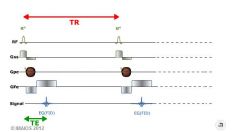
|
|
|
What does a gradient echo sequence look like
|

|
|
|
What is the symbol of the pulse on gradient echo
|

|
|
|
What occurs as a result of a pulse less than 90 degrees
|
there is less flip of the proton in the transverse plane which means less signal (for both T1 and T2)
|
|
|
What is a result of a low flip angle in GE sequences
|
The consequence of a low-flip angle excitation is a faster recovery of longitudinal magnetization that allows shorter TR/TE and decreases scan time.
|
|
|
What are 2 benefits of low flip angles
|
The advantages of low-flip angle excitations and gradient echo techniques are faster acquisitions, new contrasts between tissues and a stronger MR signal in case of short TR.
|
|
|
What does the flip angle determine
|
The flip angle determines the fraction of magnetization tipped in the transverse plane (which will produce the NMR signal) and the quantity of magnetization left on the longitudinal axis.
|
|
|
What happens as the flip angle decreases
|
If the flip angle decreases, the residual longitudinal magnetization will be higher and the recovery of magnetization for a given T1 and TR will be more complete
|
|
|
What happens as the flip angle is decreased
|
less tipped magnetization
|
|
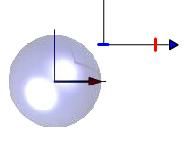
Flip angle of 90 degrees
|

Axial magnetization is greater
|
|
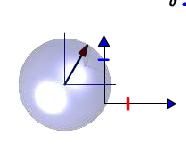
small flip angle
|

more longitudinal magnetization
|
|
|
What is a gradient that is similar to the frequency encoding gradient that is required for GE sequences
|
As there is no 180° RF pulse, a bipolar readout gradient (which is the same as the frequency-encoding gradient) is required to create an echo
|
|
|
What is required prior to the frequency gradient (which makes it bipolar)
|
The gradient echo formation results from applying a dephasing gradient before the frequency-encoding or readout gradient
|
|
|
What is the goal of the dephasing gradient that is applied just prior to the frequency encoding gradient
|
The goal of this dephasing gradient is to obtain an echo when the readout gradient is applied and the data are acquired
|
|
|
What does the bipolar gradient look like
|
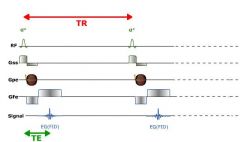
|
|
|
How long is the dephasing part of the bipolar gradient compared to the rephasing portion
|

1/2
|
|
|
What happens since the frequency encoding portion of the bipolar gradient is 2x longer than the dephasing lobe
|

Consequently, during data acquisition, the readout gradient will rephase the spins in the first half of the readout (by reversing the dephasing effect of the dephasing lobe), and the spins will dephase in the second half (due to the dephasing effect of the readout gradient).
|
|
|
What does the flip magnetization determine
|
The flip angle determines the fraction of magnetization tipped in the transverse plane (which will produce the NMR signal) and the quantity of magnetization left on the longitudinal axis (because there is going to be residual magnetization during the next GRE pulse and the smaller the flip angle the less pulse there will be)
|
|
|
What is the cause of decay of transverse magnetization
2 |
-spin-spin tissue-specific relaxation (T2) which is random
-B0 field inhomogeneities and magnetic susceptibility, which are static |
|
|
Does longitudinal magnetization decay
|
no, it goes back to alignment with the magnet of the MR machine
|
|
|
Is a bipolar readout the same as a frequency encoding gradient (readout gradient)
|
yes, a bipolar gradient is simply a frequency encoding gradient with a modified dephasing lobe.
|
|
|
What is the purpose of the dephasing lobe of the bipolar readout gradient
|
to create an echo
|
|
|
How does the dephasing lobe create an echo
|
The gradient echo formation results from applying a dephasing gradient part of the bipolar readout.
|
|
|
How is the echo created in gradient echo different than spin echo
|
the gradient causes the echo. Not a 180 degree pulse as in spin echo
|
|
|
What does the dephasing lobe of the bipolar readout gradient do
|
causes a reverse in transverse spin.
|
|
|
What is the sequence of the gradient echo
|
the dephasing lobe occurs and reverses the spin. Then the positive lobe occurs and this causes the spins to go back to positive. Then the second half of the positive readout occurs which will causes dephasing to occur
|
|
|
When does rephasing occur in the gradient echo
|
the first half of the positive lobe of the bipolar readout gradient
|
|
|
What does the bipolar gradient look like
|
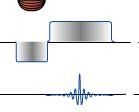
|
|
|
What is steadystate gradient echo
|
Steady-state sequences are a class of rapid magnetic resonance (MR) imaging techniques based on fast gradient-echo acquisitions in which both longitudinal magnetization (LM) and transverse magnetization (TM) are kept constant. Both LM and TM reach a nonzero steady state through the use of a repetition time that is shorter than the T2 relaxation time of tissue.
|
|
|
Is TR shorter than T2 in steady state gradient echo
|
yes
|
|
|
What happens to the residual transverse magnetization in gradient echo
|
the transverse magnetization will not have completely disappeared at the onset of the following repetition and will also be submitted to the flip caused by the excitation pulse
|
|
|
What are 2 techniques to manage residual transverse magnetization in gradient echo
|
gradient echo sequences with spoiled residual transverse magnetization
steady state gradient echo sequences that conserve residual transverse magnetization and therefore participate in the signal. |
|
|
When a gradient echo has spoiled residual transverse magnetization what is the name of the sequence
|
spoiled gradient echo sequence
|
|
|
What are the different manufacture names of spoiled gradient echo sequences
|

|
|
|
What does a spoiled gradient echo sequence look like
|
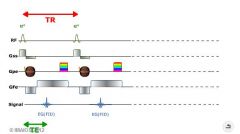
The gradient spoiler pulse is the rainbow pulse
|
|
|
Does the longitudinal and transverse magnetization reach a t constant in a steady state GRE
|
yes
|
|
|
Why would someone decide to use spoiled gradient echo sequence instead of steady state
|
In certain cases, the steady state can be detrimental, namely for obtaining T1 weighted sequences. To resolve this problem, gradients and/or RF pulses (spoilers) are used to eliminate residual transverse magnetization.
|
|
|
Does steady state gradient echo sometimes produce low quality T1W images
|
yes and this is why spoiled gradient echo sequences may be used
|
|
|
What causes increased T1W images in a gradient echo sequence
|
A large flip angle. The larger the angle the more T1 W. This occurs because the longitudinal magnetization has not recovered completely.
|
|
|
What are 2 techniques to increase the T1W in spoiled gradient echo
|
the flip angle for T1 weighting (the greater the angle, the more T1 weighting)
the TE for T2* weighting (the shorter the TE, the more T2* deweighting) |
|
|
In Gradient echo what are the 3 ways to weight images as T1 or T2
|
As in spin echo the TE and TR can be adjusted but also the flip angle. A larger flip angle will increase T1 weighting
|
|
|
What are spoiled gradient echo sequences used for
|
rapid 3D imaging during short periods of apnea (10-20 sec)
|
|
|
They are used in angiography after gadolinium injection, possibly completed by a prior acquisition to allow subtraction
|
yes
|
|
|
What are the main 2 types of GRE sequences
|

Ignore this slied
|
|
|
Is spoiled GRE sometimes called steady state
|
yes, and this is confusing but these sequences have been called steady-state INCOHERENT sequences, while the classic 'steady state' are called coherent sequences.
|
|
|
Is spoiled gradient echo considered a classic steady state sequence
|
no it is not a classic steady sate but a point of confusion is when it is called steady state incoherent sequence
|
|
|
How does steady state work
|
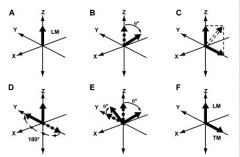
Graphs show steady-state formation in GRE pulse sequences. In A, magnetization before application of an RF excitation pulse is shown.
|
|

B, the RF pulse tips the magnetization by θ°
|

In C, the resulting tipped magnetization has an LM that recovers and a TM that decays during the TR period.
|
|
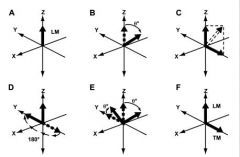
seen in D, during the TR period, the TM can precess through a 180° phase shift in the transverse plane
|

n E, the succeeding RF pulse simultaneously tips a component of residual TM back along the +Z axis and a portion of LM into the transverse plane. In F, after several TR periods, this feeding of LM into TM and vice versa establishes a steady state of both LM and TM.
|
|
|
How many lines of K space are filled with each bipolar readout gradient
|
only one but this is still really fast
|
|
|
How is the fact that GRE has a sensitivity to magnetic field inhomogenites good and bad
|
more sensitive to magnetic field inhomogeneity and magnetic susceptibility then SE
can be an advantage (imaging of hemorrhage) can be a disadvantage (loss of signal and geometric distortion) |
|
|
Does GRE typically have decreased signal to noise
|
yes
|
|
|
What are some differences of GRE to spin echo
|
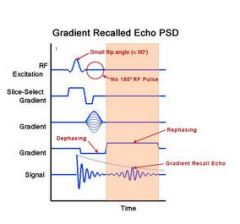
|
|
|
What determines the contrast of a GRE sequence
|
Gradient Recalled Echo (GRE) produces T2*, T1, and mixed-weighted images (T1/T2*, T2/T1) depending mainly on flip angle, TR and TE and specific GRE technique used.
|
|
|
What does the term spoiled mean in spoiled GRE
|
Residual transverse magnetization is destroyed (spoiled) after each echo
|
|
|
What are the 2 ways to spoil a gradient
|
Spoiling occurs by either:
gradient spoiling: strong spoiler gradient (shown above) RF spoiling: phase changes in RF excitation (most common) |
|
|
What does destroying the transverse magnetization by use of a strong spoiler gradient look like
|
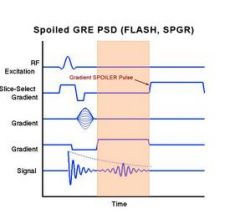
|
|
|
Why is spoiled GRE sequences used
|
Spoiled GRE imaging allows for very short TR values and high T1 contrast by using a spoiler gradient to destroy any transverse magnetization remaining after each echo
|
|
|
What is an example of an RF pulse that is used to spoil transverse magnetization and therefore increase T1 weighting in spoil GRE
|
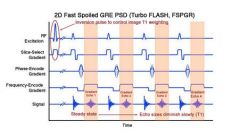
|
|
|
How many rows of K-space are filled in this example
|

4
|

